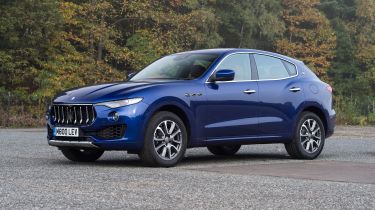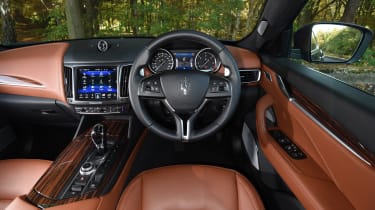Used Maserati Levante review
Everything you need to know about buying a Maserati Levante. Covering the Mk1 Levante (2017-date)
Having missed its sales targets for years, Maserati hoped to reverse the trend by introducing a full-sized SUV. This was launched five years ago, and while there’s lots to like about the Levante, it hasn’t been the sales success that Maserati hoped for.
Don’t let that put you off, though; while the Levante doesn’t lead the class in any particular area, it can make an appealing and intriguing alternative to the more obvious contenders in its segment.
Models covered
- Maserati Levante Mk1 (2017-date) - Large upmarket SUV is a rarity in the UK, but owners seem to love their cars
History
The Levante was unveiled in March 2016, with the first UK cars arriving six months later. At first only a 271bhp 3.0-litre diesel engine was available, but just over a year later a 424bhp 3.0-litre twin-turbo petrol engine was introduced in the Levante S.
For those who didn’t need quite so much performance (165mph and 0-62mph in 5.2 seconds), a 345bhp 3.0-litre petrol engine joined the range in July 2018. Anybody wanting even more zest could buy a Levante Trofeo from June 2019. With a 572bhp twin-turbo 3.8-litre petrol engine, it was capable of 186mph and 0-62mph in 4.1 seconds.
Used - available now

2023 Audi
Q4 Sportback e-tron
54,526 milesAutomaticElectric
Cash £23,363
2022 Kia
Niro
18,315 milesAutomaticPetrol1.6L
Cash £17,900
2023 Nissan
Juke
40,858 milesManualPetrol1.0L
Cash £12,287
2022 Volkswagen
T-Roc
36,779 milesAutomaticPetrol1.5L
Cash £18,600Introduced at the same time was the 523bhp Levante GTS. A facelifted Levante will arrive soon, bringing the option of a mild-hybrid edition, with a 2.0-litre four- cylinder turbocharged petrol engine.
Which one should I buy?
In the real world the V6 diesels return around 30mpg, compared with 20mpg for the V6 petrol editions, while the V8 petrol returns high teens if not thrashed.
Kit levels were reasonable rather than over-generous. Leather trim, dual-zone climate control, active air suspension, a DAB radio and a powered tailgate were standard, as were bi-xenon headlights and cruise control, but adaptive tech was optional for both. Around-view, lane-departure warning, heated front and rear seats, front and rear parking sensors and a rear parking camera were also options.
Buyers could pay £9,000 extra for GranLusso or GranSport option packs. The former added 19-inch alloys, wood trim and leather seats; the latter brought 20-inch alloys, red brake callipers and gloss-black exterior garnish, a sports steering wheel, gearshift paddles and carbon-fibre trim.
Alternatives
The Porsche Cayenne offers some extremely stiff opposition to the Levante. For almost 20 years this full-sized SUV has led the pack when it comes to driving pleasure, while the high-quality cabin is another plus point.
Also very impressive dynamically are the BMW X5 and X6. The former offers more practicality than the latter, but both have luxurious cabins and are highly specified. The Audi Q7 and Q8 give the Maserati a hard time with their efficient engines, impressive dynamics and classy cabins.
The Bentley Bentayga is worth a look if your budget is flexible, while the Mercedes GLE has some appeal, but is getting on now. Don’t forget the Range Rover Sport; it’s deeply impressive on and off the road.
What to look for
All-wheel drive
All Levantes come with part-time four-wheel drive. Normally the power is sent to the rear wheels, but if slippery the split can be 50:50.
Gearbox
All Levantes have an eight-speed automatic transmission. It’s superb and features four driving modes, something for every occasion.
Wheels
The 3.0 and 3.0d came with 18-inch alloys, and the S had 19-inch wheels. The GTS and Trofeo got 21-inch rims, while 22-inch ones were optional.
Towing
The Levante is the first Maserati available with a factory-fitted tow bar. All variations are rated at the same level, so can pull a 2,700kg braked trailer.
Interior
The Levante’s cabin feels special with its beautifully designed leather-swathed seats and door trims. Comfort levels are good and so is cabin space, as long as you only want to transport four adults; five people will find it cramped, and there’s no seven-seat option. The car’s infotainment lags behind rivals’, while the 580-litre boot is also small. Drop the seats and this jumps to 1,625 litres.
Running costs
Levantes registered after 1 April 2017 cost £490pa (hybrids £480pa) to tax in years two to six, then £155pa (hybrids £145pa).
All Levantes need servicing every 12,500 miles, but the timed interval is one year for diesels and two years for petrols. Check-ups alternate between minor and major, priced at £900 and £1,100 at a main dealer; independent specialists offer lower prices.
The minor service is an oil and filter change; the major adds fresh pollen, air and fuel filters, a new auxiliary drive belt and brake fluid. There are no cambelts to replace and no set schedule for coolant replacement.
Recalls
The Levante has been recalled seven times for reasons including the driver’s seat adjustment loom shorting out, a hose between the turbocharger and intercooler fracturing, faulty welding in the front subframe (affecting one car), incorrect ECE labelling, loose retaining bolts in the chassis and faulty LED headlights. The most recent action came in March 2020 because of stickers displaying incorrect information on the A-pillar.
Driver Power owner satisfaction
Maserati has never had any cars in our Driver Power polls, because it doesn’t sell enough in the UK. The marque doesn’t appear in our annual Brands survey, because it only has a market share of 0.05 per cent. With no buyer reviews left on carbuyer.co.uk, the only yardstick is the owners’ forums, where anecdotally the car seems to be a hit, aside from the odd isolated glitch.
Verdict
The Levante was always intended to be exclusive, but it has turned out to be even more exclusive than Maserati envisaged. Don’t be turned away by that, though, because it’s a very desirable car, even if its rivals are generally better all-rounders.
British buyers have long viewed Italian brands such as Maserati with suspicion, worrying about poor reliability or indifferent dealers, but generally those who have taken the plunge have been rewarded with an enjoyable ownership experience and a car that’s as good to drive as it is to look at.
Running costs are high, but that’s true of any car in the Levante’s segment. The key thing is that in most cases, owners seem to think that it’s a price worth paying.










